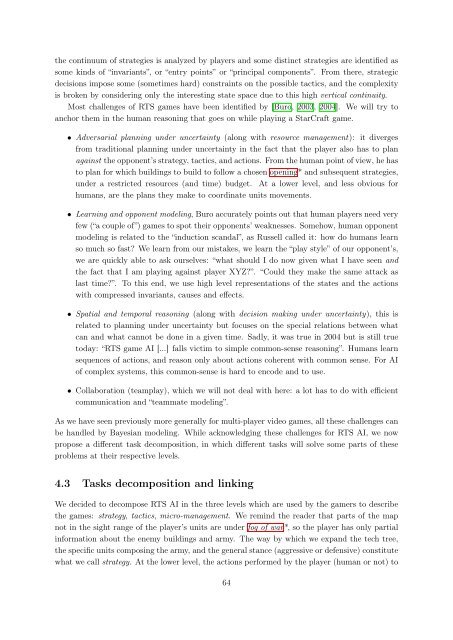Bayesian Programming and Learning for Multi-Player Video Games ...
Bayesian Programming and Learning for Multi-Player Video Games ...
Bayesian Programming and Learning for Multi-Player Video Games ...
You also want an ePaper? Increase the reach of your titles
YUMPU automatically turns print PDFs into web optimized ePapers that Google loves.
the continuum of strategies is analyzed by players <strong>and</strong> some distinct strategies are identified as<br />
some kinds of “invariants”, or “entry points” or “principal components”. From there, strategic<br />
decisions impose some (sometimes hard) constraints on the possible tactics, <strong>and</strong> the complexity<br />
is broken by considering only the interesting state space due to this high vertical continuity.<br />
Most challenges of RTS games have been identified by [Buro, 2003, 2004]. We will try to<br />
anchor them in the human reasoning that goes on while playing a StarCraft game.<br />
• Adversarial planning under uncertainty (along with resource management): it diverges<br />
from traditional planning under uncertainty in the fact that the player also has to plan<br />
against the opponent’s strategy, tactics, <strong>and</strong> actions. From the human point of view, he has<br />
to plan <strong>for</strong> which buildings to build to follow a chosen opening* <strong>and</strong> subsequent strategies,<br />
under a restricted resources (<strong>and</strong> time) budget. At a lower level, <strong>and</strong> less obvious <strong>for</strong><br />
humans, are the plans they make to coordinate units movements.<br />
• <strong>Learning</strong> <strong>and</strong> opponent modeling, Buro accurately points out that human players need very<br />
few (“a couple of”) games to spot their opponents’ weaknesses. Somehow, human opponent<br />
modeling is related to the “induction sc<strong>and</strong>al”, as Russell called it: how do humans learn<br />
so much so fast? We learn from our mistakes, we learn the “play style” of our opponent’s,<br />
we are quickly able to ask ourselves: “what should I do now given what I have seen <strong>and</strong><br />
the fact that I am playing against player XYZ?”. “Could they make the same attack as<br />
last time?”. To this end, we use high level representations of the states <strong>and</strong> the actions<br />
with compressed invariants, causes <strong>and</strong> effects.<br />
• Spatial <strong>and</strong> temporal reasoning (along with decision making under uncertainty), this is<br />
related to planning under uncertainty but focuses on the special relations between what<br />
can <strong>and</strong> what cannot be done in a given time. Sadly, it was true in 2004 but is still true<br />
today: “RTS game AI [...] falls victim to simple common-sense reasoning”. Humans learn<br />
sequences of actions, <strong>and</strong> reason only about actions coherent with common sense. For AI<br />
of complex systems, this common-sense is hard to encode <strong>and</strong> to use.<br />
• Collaboration (teamplay), which we will not deal with here: a lot has to do with efficient<br />
communication <strong>and</strong> “teammate modeling”.<br />
As we have seen previously more generally <strong>for</strong> multi-player video games, all these challenges can<br />
be h<strong>and</strong>led by <strong>Bayesian</strong> modeling. While acknowledging these challenges <strong>for</strong> RTS AI, we now<br />
propose a different task decomposition, in which different tasks will solve some parts of these<br />
problems at their respective levels.<br />
4.3 Tasks decomposition <strong>and</strong> linking<br />
We decided to decompose RTS AI in the three levels which are used by the gamers to describe<br />
the games: strategy, tactics, micro-management. We remind the reader that parts of the map<br />
not in the sight range of the player’s units are under fog of war*, so the player has only partial<br />
in<strong>for</strong>mation about the enemy buildings <strong>and</strong> army. The way by which we exp<strong>and</strong> the tech tree,<br />
the specific units composing the army, <strong>and</strong> the general stance (aggressive or defensive) constitute<br />
what we call strategy. At the lower level, the actions per<strong>for</strong>med by the player (human or not) to<br />
64


